Everlane Shoe Park
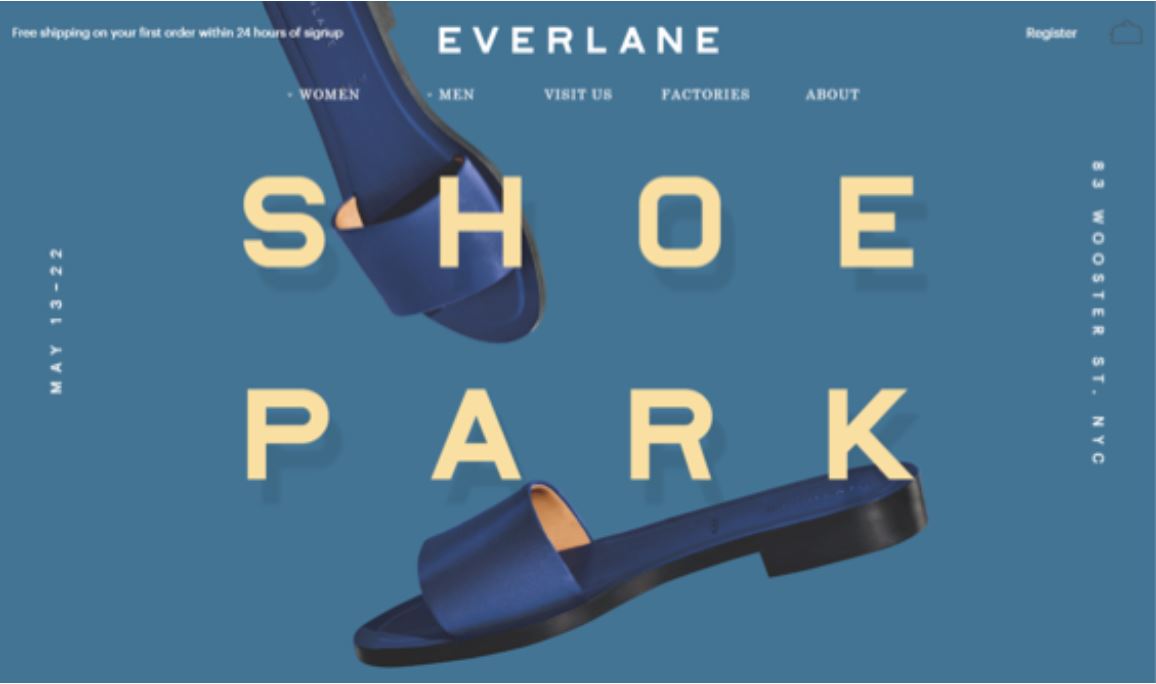
Everlane, an e-commerce apparel startup based in San Francisco, held a shoe and bag pop-up in New York’s SoHo neighborhood last week. The Shoe Park pop-up store ran from May 13 through May 22. While Everlane has held other pop-up events, the Shoe Park retail space was its first experiment with in-store inventory.
COMPANY OVERVIEW
When Everlane was founded in 2010, offering a single T-shirt style, its mission was to provide consumers with “radical transparency.” The company challenges its customers to “Know your factories. Know your costs. Always ask why.” Everlane makes good on its word by breaking down the cost of every item on its website into materials, hardware, labor, duties and transport. The company also provides extensive information on its factories, so customers can be confident that they are purchasing a socially conscious—and well-made—product.
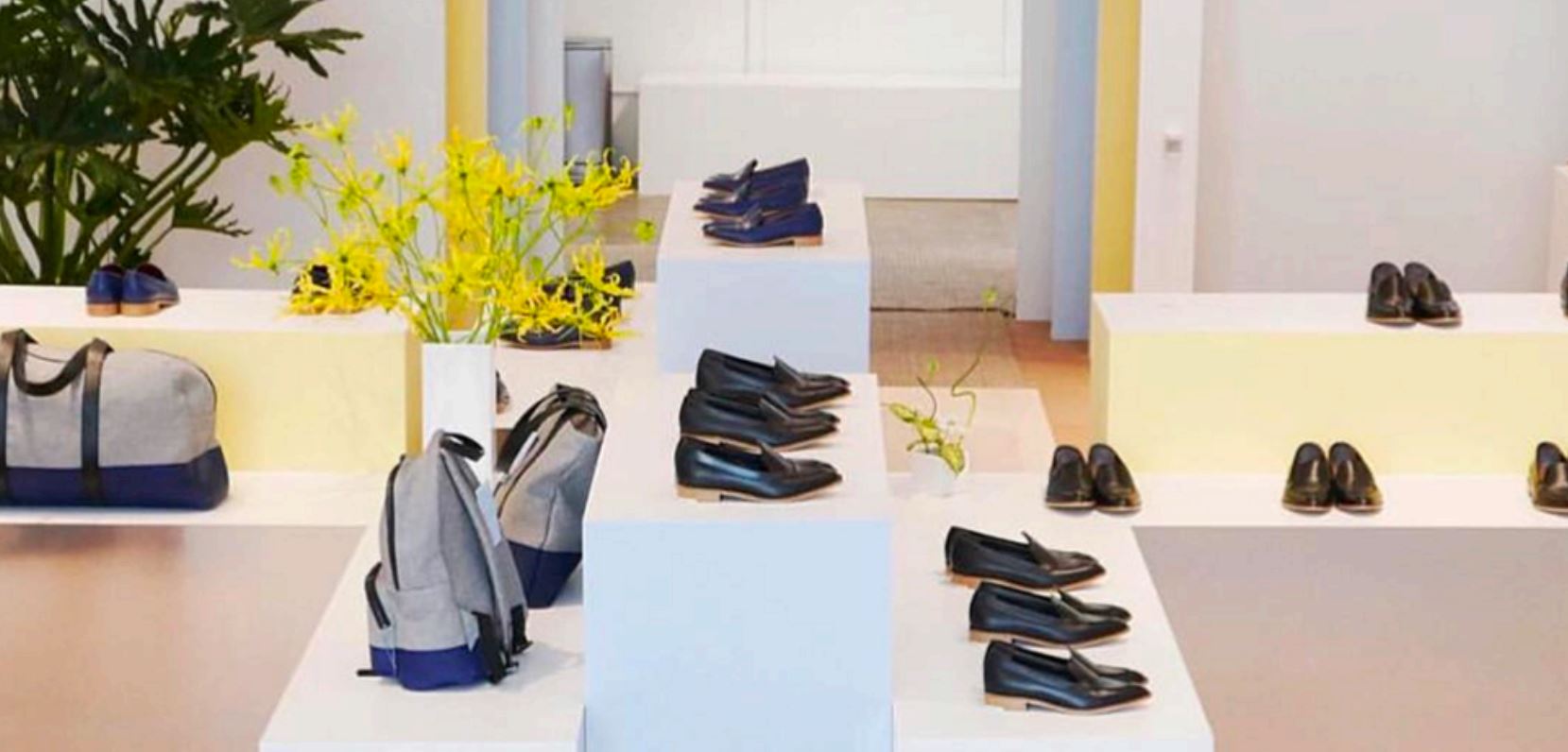
This radical approach directly addresses social issues associated with the fashion and retail industries, as well as retail markups—which are often eight to 10 times production cost. Founder and CEO Michael Preysman has said, “We want the look of Céline and the ethics of Patagonia.” Often referred to as the next J.Crew, Everlane has come a long way since first launching its $15 Box-Cut Tee. It has expanded its offering to sweaters, jackets, leisurewear, shoes, bags and menswear, with prices ranging from $15 for the original T-shirt to $345 for an Italian-made leather tote. In 2014, Everlane’s revenue doubled from $12 million in 2013, and its gross profits more than doubled, from $8.1 million to $18 million, according to financial researcher PrivCo. The firm estimates that Everlane’s 2015 sales totaled $35 million.
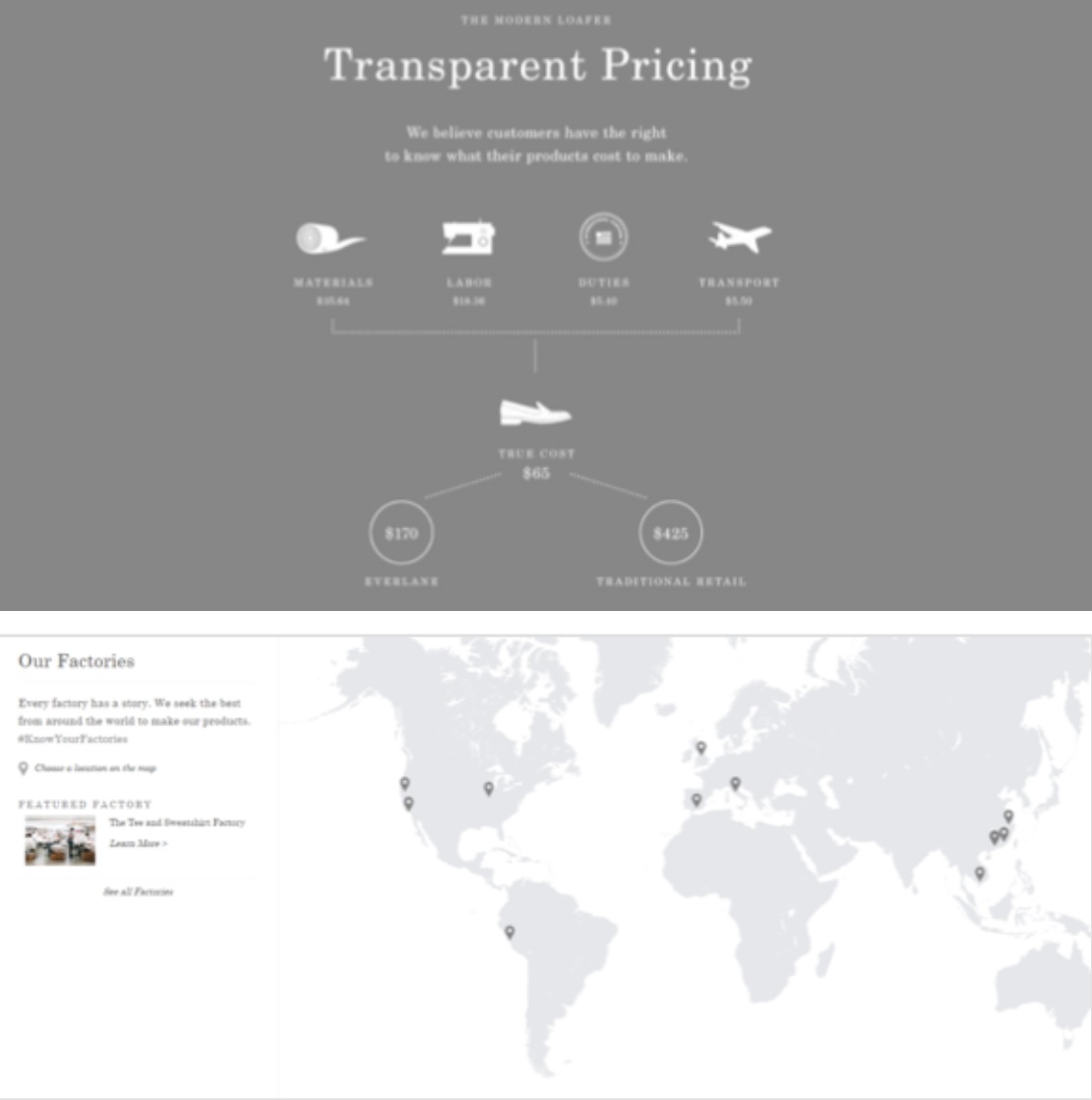
EVERLANE SHOE PARK

Everlane seemed to be dipping its toes into the brick-and-mortar waters with the Shoe Park pop-up, but the physical retail space definitely reflected the company’s e-commerce roots. Before entering the space, visitors had to check in with an associate, and provide their name and email address. Next, they were asked to remove their shoes, checking them in at the front before entering the shopping area. Everlane described the space as “an elevated playground,” and advertised it by saying, “There’s only one rule in our playground: You have to leave your shoes at the door. From there you can walk, sit, climb and jump through our interactive installations—all designed to let you try out our shoes while having a little fun.”

The pop-up was beautifully—and smartly—designed by Robert Storey of StoreyStudio, who wanted to create installations that “both display and engage.” With playground influences apparent in the shoe displays, the space lived up to its concept. The surfaces behind the shoes were reflective, so shoppers could get an instant 360-degree look at the product. Instead of making shoppers wait while a store associate fetched their size from a back room, Everlane had all sizes on display, so shoppers could try on different styles at their leisure. Everlane also offered shoppers complimentary coffee, juice, rosé wine and even Shake Shack custard at different points over the week.
While Everlane has previously organized temporary retail spaces where shoppers could see products in person, this was the company’s first foray into in-store inventory. “Play with a pair you like and you’ll be able to leave with them that day,” the event’s webpage promised. After making their shoe and bag selections, shoppers checked out with store associates armed with iPads. Receipts were conveniently emailed to the address shoppers had provided upon arrival, and they were welcome to continue exploring the space or indulging in treats before picking up their purchase on their way out, as they got their shoes back. If they were not satisfied with their purchase, shoppers could make in-store returns through May 22—the last day of the pop-up—or via mail within 90 days of purchase.
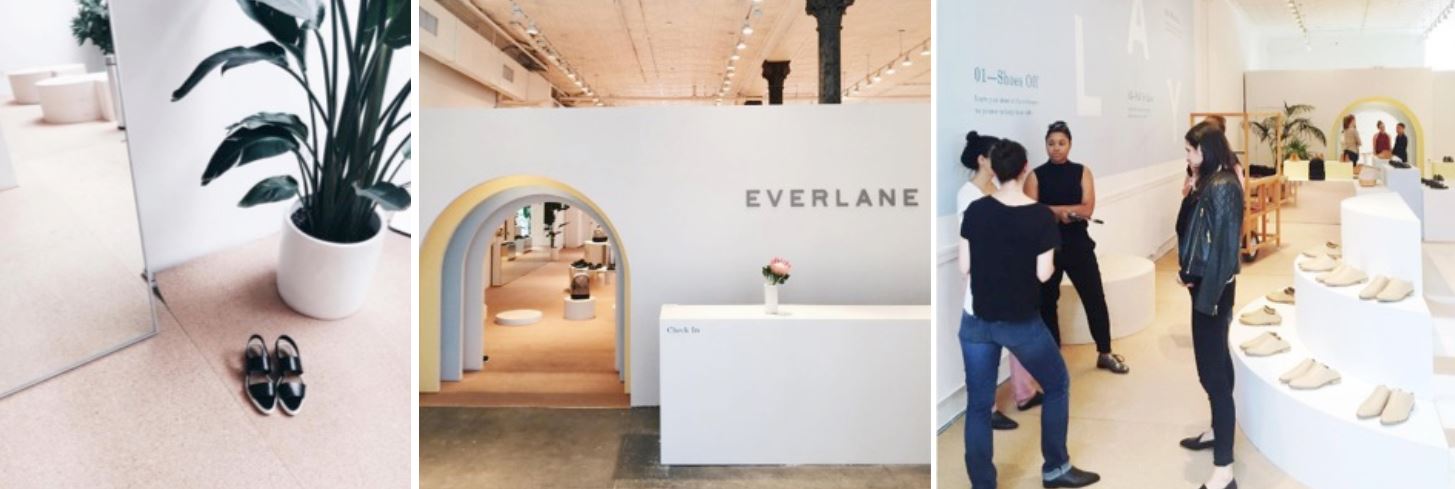
SOCIAL MEDIA
Social media plays a big role in Everlane’s success. As an only- online startup, the company needed to leverage social media and word-of-mouth marketing. It now boasts a strong social media presence, with over 140,000 page likes on Facebook and 230,000 Instagram followers. Shoe Park alone generated over 300 Instagram posts from shoppers who used the hashtag #ShoePark.
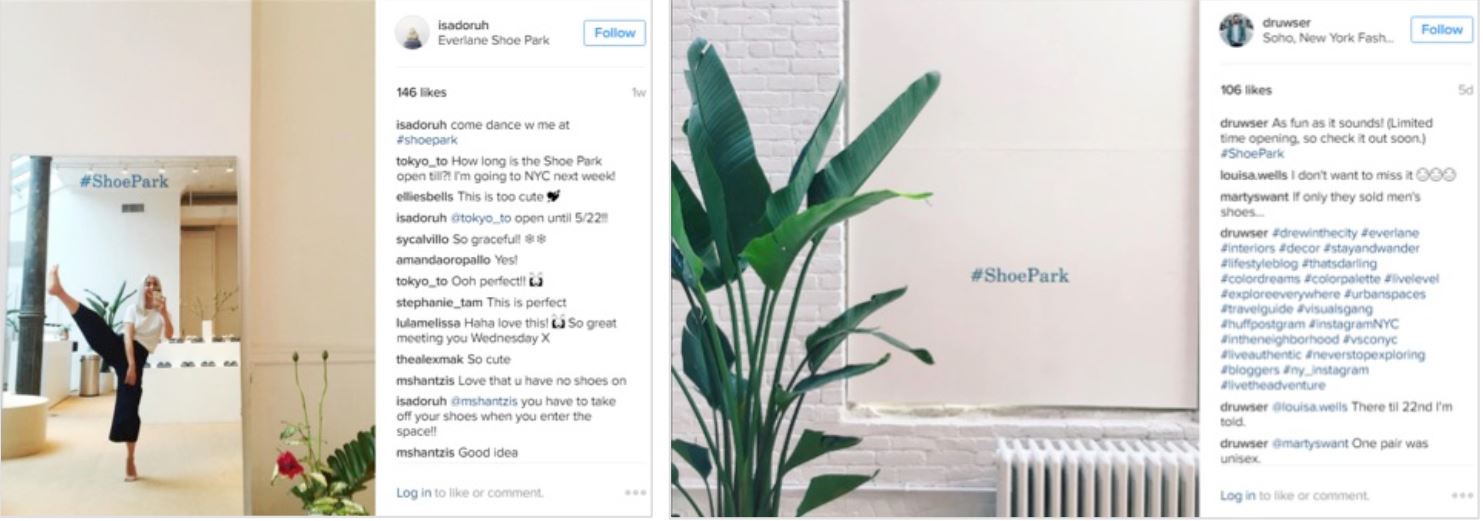
Two examples of the 300+ Instagram posts tagged with #ShoePark
Everlane encouraged shoppers to share their experience on social media by posting the #ShoePark hashtag in a few places around the store. Below are some of Everlane’s own #ShoePark Instagram posts.

Everlane’s #ShoePark Instagram posts show the construction of the space as well as happenings during the pop-up event, extending the company’s focus on transparency to the physical space.
Shoe Park offered a simple yet engaging shopping experience that was consistent with, and helped further build, the Everlane brand. Minimalist, well designed and customer focused, Shoe Park reflected many of Everlane’s core tenets. The company is constantly experimenting with new ideas for e-commerce, including one-hour delivery, “choose what you pay” sales to deal with overstock, and a combo weather and shopping app that suggests outfits based on the weather conditions in the user’s area. While Everlane does not have plans to open any brick-and-mortar stores and has yet to see a net profit , we think it is a retailer to keep an eye on as it continues to innovate in the e-commerce space.

 This radical approach directly addresses social issues associated with the fashion and retail industries, as well as retail markups—which are often eight to 10 times production cost. Founder and CEO Michael Preysman has said, “We want the look of Céline and the ethics of Patagonia.” Often referred to as the next J.Crew, Everlane has come a long way since first launching its $15 Box-Cut Tee. It has expanded its offering to sweaters, jackets, leisurewear, shoes, bags and menswear, with prices ranging from $15 for the original T-shirt to $345 for an Italian-made leather tote. In 2014, Everlane’s revenue doubled from $12 million in 2013, and its gross profits more than doubled, from $8.1 million to $18 million, according to financial researcher PrivCo. The firm estimates that Everlane’s 2015 sales totaled $35 million.
This radical approach directly addresses social issues associated with the fashion and retail industries, as well as retail markups—which are often eight to 10 times production cost. Founder and CEO Michael Preysman has said, “We want the look of Céline and the ethics of Patagonia.” Often referred to as the next J.Crew, Everlane has come a long way since first launching its $15 Box-Cut Tee. It has expanded its offering to sweaters, jackets, leisurewear, shoes, bags and menswear, with prices ranging from $15 for the original T-shirt to $345 for an Italian-made leather tote. In 2014, Everlane’s revenue doubled from $12 million in 2013, and its gross profits more than doubled, from $8.1 million to $18 million, according to financial researcher PrivCo. The firm estimates that Everlane’s 2015 sales totaled $35 million.

 Everlane seemed to be dipping its toes into the brick-and-mortar waters with the Shoe Park pop-up, but the physical retail space definitely reflected the company’s e-commerce roots. Before entering the space, visitors had to check in with an associate, and provide their name and email address. Next, they were asked to remove their shoes, checking them in at the front before entering the shopping area. Everlane described the space as “an elevated playground,” and advertised it by saying, “There’s only one rule in our playground: You have to leave your shoes at the door. From there you can walk, sit, climb and jump through our interactive installations—all designed to let you try out our shoes while having a little fun.”
Everlane seemed to be dipping its toes into the brick-and-mortar waters with the Shoe Park pop-up, but the physical retail space definitely reflected the company’s e-commerce roots. Before entering the space, visitors had to check in with an associate, and provide their name and email address. Next, they were asked to remove their shoes, checking them in at the front before entering the shopping area. Everlane described the space as “an elevated playground,” and advertised it by saying, “There’s only one rule in our playground: You have to leave your shoes at the door. From there you can walk, sit, climb and jump through our interactive installations—all designed to let you try out our shoes while having a little fun.”
 The pop-up was beautifully—and smartly—designed by Robert Storey of StoreyStudio, who wanted to create installations that “both display and engage.” With playground influences apparent in the shoe displays, the space lived up to its concept. The surfaces behind the shoes were reflective, so shoppers could get an instant 360-degree look at the product. Instead of making shoppers wait while a store associate fetched their size from a back room, Everlane had all sizes on display, so shoppers could try on different styles at their leisure. Everlane also offered shoppers complimentary coffee, juice, rosé wine and even Shake Shack custard at different points over the week.
While Everlane has previously organized temporary retail spaces where shoppers could see products in person, this was the company’s first foray into in-store inventory. “Play with a pair you like and you’ll be able to leave with them that day,” the event’s webpage promised. After making their shoe and bag selections, shoppers checked out with store associates armed with iPads. Receipts were conveniently emailed to the address shoppers had provided upon arrival, and they were welcome to continue exploring the space or indulging in treats before picking up their purchase on their way out, as they got their shoes back. If they were not satisfied with their purchase, shoppers could make in-store returns through May 22—the last day of the pop-up—or via mail within 90 days of purchase.
The pop-up was beautifully—and smartly—designed by Robert Storey of StoreyStudio, who wanted to create installations that “both display and engage.” With playground influences apparent in the shoe displays, the space lived up to its concept. The surfaces behind the shoes were reflective, so shoppers could get an instant 360-degree look at the product. Instead of making shoppers wait while a store associate fetched their size from a back room, Everlane had all sizes on display, so shoppers could try on different styles at their leisure. Everlane also offered shoppers complimentary coffee, juice, rosé wine and even Shake Shack custard at different points over the week.
While Everlane has previously organized temporary retail spaces where shoppers could see products in person, this was the company’s first foray into in-store inventory. “Play with a pair you like and you’ll be able to leave with them that day,” the event’s webpage promised. After making their shoe and bag selections, shoppers checked out with store associates armed with iPads. Receipts were conveniently emailed to the address shoppers had provided upon arrival, and they were welcome to continue exploring the space or indulging in treats before picking up their purchase on their way out, as they got their shoes back. If they were not satisfied with their purchase, shoppers could make in-store returns through May 22—the last day of the pop-up—or via mail within 90 days of purchase.



